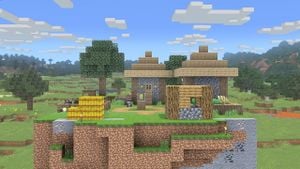| Welcome to SmashWiki! Log in or create an account and join the community, and don't forget to read this first! |
| Notices |
|---|
| The Skill parameter has been removed from Smasher infoboxes, and in its place are the new "Best historical ranking" and "Best tournament result" parameters. SmashWiki needs help adding these new parameters to Smasher infoboxes, refer to the guidelines here for what should be included in these new parameters. |
| When adding results to Smasher pages, include each tournament's entrant number in addition to the player's placement, and use the {{Trn}} template with the matching game specified. Please also fix old results on Smasher pages that do not abide to this standard. Refer to our Smasher article guidelines to see how results tables should be formatted. |
| Check out our project page for ongoing projects that SmashWiki needs help with. |
Minecraft World
| Minecraft Minecraft World | |
|---|---|
  Minecraft World as it appears in Ultimate. | |
| Universe | Minecraft |
| Appears in | Ultimate |
| Availability | Downloadable |
| Crate type | Normal |
| Maximum players | 8 |
Minecraft World (マインクラフト ワールド, Minecraft World) is a DLC stage in Super Smash Bros. Ultimate. It is bundled with Steve in Challenger Pack 7, which is also part of the Fighters Pass Vol. 2.
Stage Overview
The stage is set in Minecraft's Overworld and has a largely standard design, being a flat platform with edges that extend to the lower blast zone. Different materials for mining can be found along the main stage. It features a day/night cycle, and different mobs may be seen wandering the stage during different times of day; they do not affect gameplay. The stage randomly loads in different biomes, which cause different obstacles to appear. Any obstacles can be destroyed through attacks, including mining, and will not respawn. However, the materials found through mining on the main stage will always be the same regardless of biome.
- The plains biome is standard, and features a town of Villagers who perform farmwork. At night, the Villagers retire to their homes and monsters come out, which catch fire and burn up in the morning, repeating the cycle.
- The birch forest features sheep and cows. There are two platforms on different levels hidden within birch trees.
- The savanna features acacia trees, and one platform hidden with a tree.
- The taiga includes Villagers, mossy stone, and a conifer tree.
- The tundra includes Villagers and an igloo in the center.
- The stone shore includes a single platform and an irregular stone formation in the center.
Battlefield and Ω forms
In its Battlefield and Ω forms, the stage always loads in the plains biome, but retains its day/night cycle. It is largely the same other than being resized and reshaped to match Battlefield and Final Destination. The Battlefield form's platforms are similar to those found on the birch forest, savanna, and stone shore biomes. The main stage has a path made of dirt rather than varied terrain, since the terrain of Battlefield and Ω stages do not affect which materials can be mined.
Origin
In Minecraft, worlds are created through by choosing the "Create New World" option on the world select screen. Worlds are randomly generated based off of seeds; by entering a series of numbers and letters, it is possible to manipulate this seed.
Within a randomly-generated world, there are a number of biomes, which determine the weather, terrain, and mobs that will spawn in that part of the world. The variations of this stage represent a selection of the biomes.
The Plains are the most generic biome: a mostly flat, grassy area filled with typical wildlife such as cows, chickens, pigs, and sheep.
A Birch Forest is a variety of forest biome, filled with birch trees and other flora across a hilly landscape. However, like the Plains, there are no other particularly unique features.
The Savanna is a warm, mostly flat biome filled with tall grass and acacia trees. It is possible for horses, donkeys, and llamas to spawn in a Savanna and it will never rain. Savannas often border Plains and Desert biomes.
Taigas are cold counterparts to forest biomes, filled with spruce trees, sweet berry bushes, and other flora. Rabbits, foxes, and wolves often spawn in taigas.
The Snowy Tundra is an uncommon and, as its name implies, snowy biome filled with flora that has adapted to the cold. Igloos, which often contain treasure chests and other items, can be found in Snowy Tundras. It is also possible to encounter polar bears and Strays, a variant of the Skeleton mob that has frozen. It only snows rather than rains in a Snowy Tundra.
Stone Shores are variants of beach biomes that are usually found bordering mountainous regions. These beaches are filled with varieties of stone rather than sand and it is common to find waterfalls and lavafalls. Turtles, which are generally found on beaches, cannot spawn in stone shores.
Villages are unique structures that can be found in a variety of biomes, including Plains, Savannas, Snowy Tundras, and Taigas. The Plains variant, which appears in Smash, is the type that has been in the game the longest and represents the most generic village, where villagers farm in wooden houses. Villages often contain loot, but it is possible to trade with the villagers, as well. At night, all villagers will retreat into their homes to sleep lest they be turned into Zombie Villagers or otherwise killed by hostile mobs.
| show Stages in Super Smash Bros. Ultimate |
|---|
| show
|
|---|
